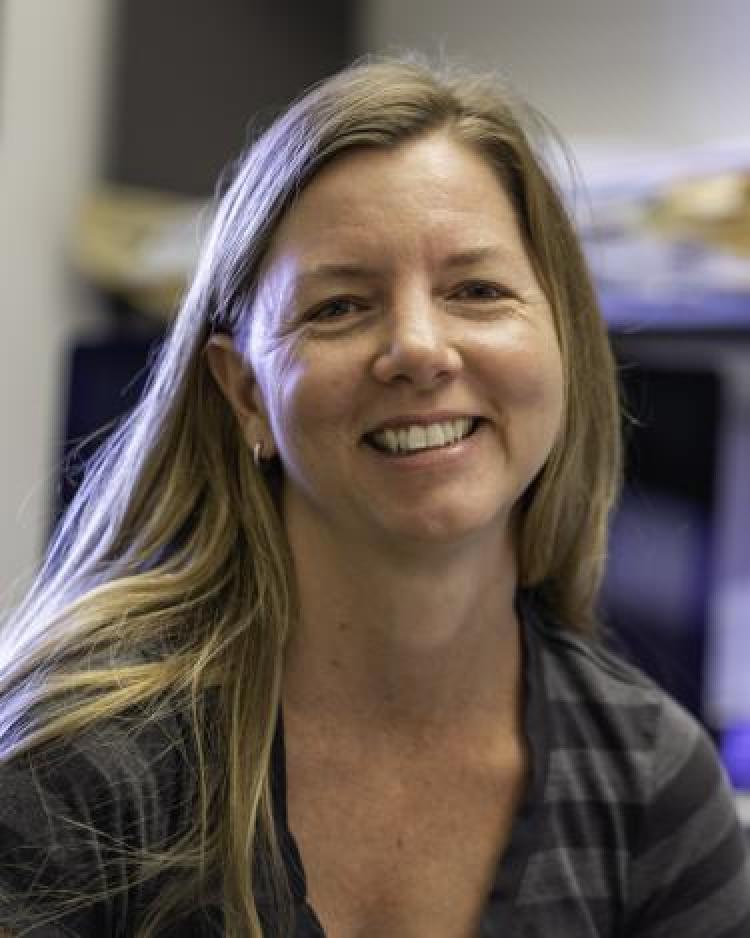Pioneering biologist elected to National Academy of Sciences
Gia Voeltz, CU Boulder professor of molecular, cellular and developmental biology, changed the way we visualize cells
Think back to your middle school biology days, and you might recall textbook images of a circular cell, its internal organs, or “organelles,” spread out across it with little contact or interaction.
Shortly after cell biologist Gia Voeltz arrived at the University of Colorado Boulder in 2006, she peered through one of the world’s strongest electron microscopes and saw something different: One of those organs, the endoplasmic reticulum, was actually touching the others, seemingly influencing their position, growth and behavior.
The discovery forever changed our understanding of the structure and function of cells, helped ignite new interest in the field of cell biology and is now shedding new light on what goes wrong to cause diseases, including neurodegenerative diseases.

At the top of the page: Gia Voeltz in her lab. Above: Gia Voeltz.
This month, it also earned Voeltz a place in the National Academy of Sciences, one of the highest professional honors a scientist can achieve.
The NAS also elected theoretical physicist Anna Maria Rey, a professor adjoint of physics and fellow with the National Institute of Standards and Technology and JILA, to the organization. (Read more about that here).
“This is a huge recognition not just for me and my lab members but for our entire community,” said Voeltz, a professor of molecular, cellular and developmental biology (MCDB). “I feel so fortunate that I’ve had the kind of environment that we have here at CU to be able to do this work.”
Voeltz’ research centers around the endoplasmic reticulum (ER), an organelle historically drawn as something resembling a stack of pancakes and set apart from the kidney-shaped mitochondria (the cell’s energy centers) and round endosomes (which regulate cell growth).
Keith Porter, who chaired the MCDB department in the late 1960s and established what remains one of the world’s most sophisticated electron microscopy facilities on campus, coined the term “endoplasmic reticulum” in the early 1950s.
But until Voeltz’ discovery, the ER was considered a workhorse, viewed as a simple protein factory set apart from the intracellular action.
In reality, her lab discovered, the ER is more like a lacy and dynamic coral, spread out across the cytoplasm with the cell’s other organs, clinging to it like ornaments on a tree. Instead of those organs’ being isolated and doing their own thing, they are all connected and communicating through the ER.
“Everyone thought they knew what the ER did, but it turns out it does a lot more than we thought,” said Voeltz. “And it is extremely medically relevant.”
In 2018, Voeltz was named a Howard Hughes Medical Institute (HHMI) investigator and awarded $8 million to take her research wherever she wanted.
She and her trainees have since doubled down on exploring what happens when things go wrong with the ER.
For instance, she notes, a host of deadly RNA viruses including SARS CoV-2, the virus that causes COVID 19, wrap themselves in the ER membrane “like an invisible cloak” to evade the immune system and replicate.
Voeltz and her students are among a handful of groups in the world exploring the ER’s role in viral replication and imagine a day when that process could be disrupted to prevent or treat such infections.
Meanwhile, she’s also looking into how certain proteins regulate the critical interaction between the ER and other organelles, and what happens when those proteins are mutated in developing brain and nerve cells.
It’s really the first step in understanding how a mutation in a gene can lead to a mutant protein and affect the whole biology of the neuron. If we could somehow correct that, we could potentially treat a host of diseases that are currently incurable.”
The lab is currently studying the roots of an incurable childhood neurodegenerative disorder called hereditary spastic paraplegia, HSP, that weakens, stiffens and causes tremors in the legs and can also cause blindness and cognitive impairment.
In a recent paper, they identified a key protein that influences the shape of the ER and, in turn, influences how axons—nerve fibers that carry signals from the brain to the limbs—form.
When the protein is missing or mutated, they found, a domino-effect occurs, with the ER misshapen, other organelles disrupted and axons developing improperly.
“It’s really the first step in understanding how a mutation in a gene can lead to a mutant protein and affect the whole biology of the neuron. If we could somehow correct that, we could potentially treat a host of diseases that are currently incurable.”
For now, what Voeltz is most proud of is the way her research has shaped biology education.
Already, some textbook illustrators have begun to draw the cell in a different way because of her work. She hopes that continues.
“I look forward to the day when the front cover of a cell biology textbook has a picture of organelles that are all interacting with each other. That would make me really proud.”

